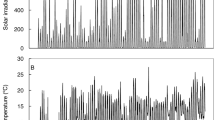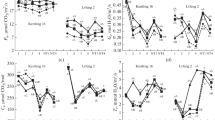Abstract
Low temperature is one of the major environmental factors determining the growth rate ofCamellia sinensis (L.), and photosynthesis is one major metabolic process commonly used as a tool for identifying low temperature stress effects on plants. The Fv/Fm values at 6:30 a.m. (300-400 umol m-2s-1) did not vary much between the clones of tea plants. Further, when the light incidence increased at mid noon hours (1700-1800 µmol m-2s-1), the Fv/Fm values recorded a decline, irrespective of the clones. Of the 10 clones of tea plants under investigation, 3 clones, namely CRA-6017, TTL-6 and SMP-1, recorded a sharp decrease in the Fv/Fm ratio by 2 p.m. The malondialdehyde (MDA) levels in all the clones increased from 9 a.m. (1500-1700 µmol m-2s-1) to 2 p.m. and from 4:30 p.m. (900-1100 µmol m-2s-1) onwards it started to decrease and reach the levels equivalent to 6:30 a.m. by 7 p.m. (5–10 µmol m-2s-1 ). But the clones of TTL-1, TTL-4 and UPASI-9 showed low temperature tolerance as appeared in chlorophyll a fluorescence response. They showed a higher percentage increase in MDA levels, as compared to TTL-6, CRA-6017 and SMP-1, which showed low temperature susceptibility. But the reduction in the level of MDA by 4:30 p.m. (recovery) was faster in the clones TTL-1, TTL-4 and UPASI-9, as compared to TTL-6, SM/OM/54 and SMP-1. The result indicates that in TTL-6, SMP-1 and SM/ OM/54, the toxic oxygen species scavenging mechanisms may be less functional as compared to other clones. The percentage increase of proline and carotenoids was higher in clones TTL-1, TTL-4 and UPASI-9 as compared to TTL-6, CRA-6017 and SMP-1.
Similar content being viewed by others
Literature cited
Alam B Jacob J (2002) Overproduction of photosynthetic electrons is asociated with chilling injury in green leaves. Photosyn40: 91–95
Alia, Prasad KVSK Saradhi PP (1995) Effect of zinc on free radicals and proline inBrassica juncea andCajanus cajan. Phytochem39: 45–47
Arnon DI (1949) Copper enzymes in isolated chloroplast polyphenoloxidase in Betavulgaris. Plant Physiol24: 1–15
Arora A Sairam RK Srivastava GC (2002) Oxidative stress and antioxidative system in plants. Curr Sci82: 1227- 1238
Asada K (1994) Production and action of active oxygen species in photosynthetic tissues,In CH Foyer, PM Mullineaux, eds, Causes of Photooxidative stress and amelioration of defense systems in plants. CRC Press, Boaca Raton, pp 77–104
Barua DN (1989) Science and practice in tea culture. Tea Research Association Calcutta, Jorhat
Bates LS Waldern RP Teare I (1973) Rapid determination of free proline for water-stress studies. Plant Soil39: 205–207
Berry J Björkman O (1980) Photosynthetic response and adaptation to temperature in higher plants. Ann Rev Plant Physiol31: 491–543
Bisht MS, Vyas P, Bag N, Nandi SK, Palni LMS (1996) Chlorophyll fluorescence: A tool to assess plant stress. Screening of tea clones for frost tolerance. National Symposium on Modern Trends in Plant Physiology, Pantnagar, pp 50–55
Björkman O Powles SB (1984) Inhibition of photosynthetic reactions under water stress: interaction with light level. Planta161: 490–504
Bolhar-Nordenkampf HR Öquist G (1993) Chlorophyll fluorescence as a tool in photosynthesis research,In PO Hall, JMO Schurlak, HR Bolhar-Nordenkampf, RC Leegood, SP Long, eds, Photosynthesis and Production in a Changing Environment: A Field and Laboratory Manual. Chapman and Hall, London, pp 193–206
Constant S Perewoska I Alfonso M Kirilovsky D (1997) Expression of thepsbA during photoinhibition and recovery inSynechocystis PCC 6714: Inhibition and damage of transcriptional and translational machinery prevent the restoration of photosystem II activity. Plant Mol Biol34: 1–13
Dubey RS (1997) Photosynthesis in plants under stressful conditions,In M Pessarakli, eds, Handbook of Photosynthesis. Marcel Dekker, New York, pp 859–876
Fuchinoue H (1985) Time course of cold injury of tea plants related to the climate,In H Fuchinoue, ed, Special Report on Cold Injury in Tea Plant. Saitama Prefectural Tea Experimental Station, Japan, pp 24–28
Giardi MT Masojidek, J Godde D (1997) Effects of abiotic stresses on the turnover of the D1 reaction centre II protein. Physiol Plant101: 635–642
Halliwell B Gutteridge JMC (1986) Iron and free radical reactions: Two aspects of antioxidant protection. Trends Biochem Sci11: 372–375
He JX Wang J Liang HG (1995) Effects of water stress on photochemical function and protein metabolism of photosystem II in wheat leaves. Physiol Plant93: 771–777
Heath RL Packer L (1968) Photoperoxidation in isolated chloroplasts. I. Stoichiometry of fatty acid peroxidation. Arch Biochem Biophys125: 189–198
Hudson JB Muraleedharan N (1996) Frost damage to tea. Planters’ Chronicle91: 571–575
Huner NPA Oquist G Hurry VM Krol M Falk S Griffith M (1993) Photosynthesis, photoinhibition and low tem- perature acclimation in cold tolerant plants. Photosyn Res37: 19–39
Janssen LHJ VanOeveren JC, van Hasselt PR Kuiper PJC (1995) Genotypic variation in chlorophyll fluorescence parameters, photosynthesis and growth of tomato grown at low temperature and low irradience. Photosynthetica31: 301–314
Joshi SC Palni LMS (1998) Clonal variation in temperature response of photosynthesis in tea. Plant Sci137: 225–232
Keren N Berg A van Kan PJM Levanon H Ohad I (1997) Mechanism of Photosystem II photoinactivation and D1 protein degradation at low light: The role of back electron flow. Proc Nat Acad Sci USA94: 1579–1584
Kitajiima M Butler WL (1975) Quenching of chlorophyll fluorescence and primary photochemistry in chloroplast by dibromothymoquinone. Biochem Biophys Acta376: 105–115
Krause GH (1988) Photoinhibition of photosynthesis. An evaluation of damaging and protective mechanisms. Physiol Plant74: 566–574
Larcher W (1994). Photosynthesis as a tool for indicating temperature stress events,In ED Schulze, MM Caldwell, eds, Ecophysiology of Photosynthesis. Springer-Verlag, Berlin, pp 261–277
Matysik J Alia, Bhalu B Mohanty P (2002) Molecular mechanisms of quenching of reactive oxygen species by proline under stress in plants. Curr Sci82: 525–531
Powles SB (1984) Photoinhibition of photosynthesis induced by visible light. Ann Rev Plant Physiol35: 15–44
Puthur JT (2000) Photosynthetic events inSesbania sesban (I.) Merril in relation to osmotic stress under various developmental stages. Ph.D. thesis. Jamia Millia Islamia (A Central University), New Delhi
Puthur JT Sharmila P Prasad KVSK Saradhi PP (1996) Proline overproduction: A means to improve stress tolerance in crop plants. Botanica46: 163–169
Ritchie GA (1991) Measuring cold hardiness,In JP Lassoie, TM Hinckley, eds, Techniques and Approaches in Forest Tree Ecophysiology. CRC Press, Boston, pp 557–582
Saradhi PP Arora AS Prasad KVSK (1995) Proline accumulates in plants exposed to UV radiation and protects them against UV induced peroxidation. Biochem Biophy Res Commun209: 1–5
Scandalio JG (1993) Oxygen stress and Superoxide dismutase. Plant Physiol101: 7–12
Schreiber U Bilger W (1993) Progress in chlorophyll fluorescence research: Major developments during the past years in retrospect. Prog Bot54: 151–173
Siefermann-Harms D (1987) The light-harvesting and protective functions of carotenoids in photosynthetic membranes. Physiol Plant69: 561–568
Smirnoff N Cumbes QJ (1989) Hydroxyl radical scavenging activity of compatible solutes. Phytochem28: 1057–1060
Vyas P Bisht MS Palni LMS (1998) Chlorophyll a fluorescence: A tool for screening tea clones for frost tolerance. Dev Plantations Crops Res22: 98–102
Wise RR (1995) Chilling-enhanced photooxidation: The production, action and study of reactive oxygen species produced during chilling in the light. Photosyn Res45: 79–97
Young AJ Orset S Tsavlos AJ (1997) Carotenoid in higher plant photosynthesis,In M Pessarakli, ed, Handbook of Photosynthesis. Marcel Dekker, New York, pp 859–876
Zelitch I (1982) The close relationship between net photosynthesis and crop yield. Biosci32: 796–802
Author information
Authors and Affiliations
Corresponding author
Rights and permissions
About this article
Cite this article
Netto, L.A., Jayaram, K.M., Haridas, P. et al. Characterization of photosynthetic events and associated changes in various clones of tea(camellia sinensis l) under low temperature conditions. J. Plant Biol. 48, 326–331 (2005). https://doi.org/10.1007/BF03030530
Received:
Accepted:
Issue Date:
DOI: https://doi.org/10.1007/BF03030530




